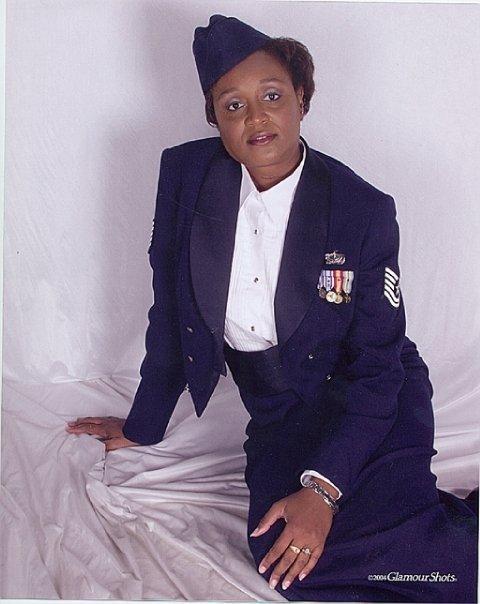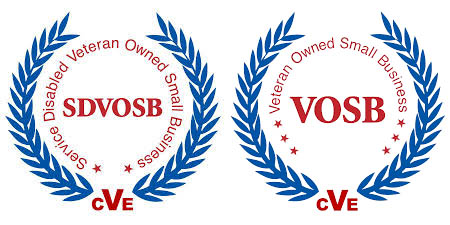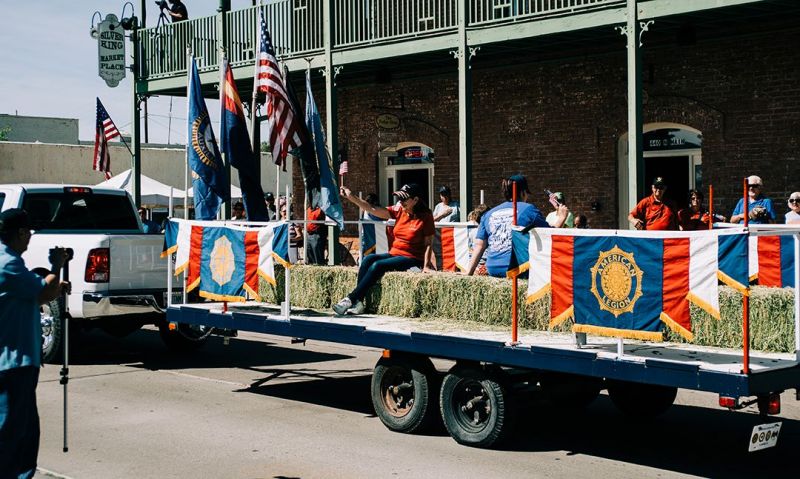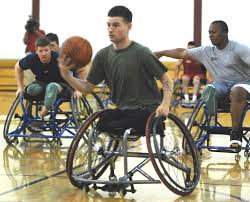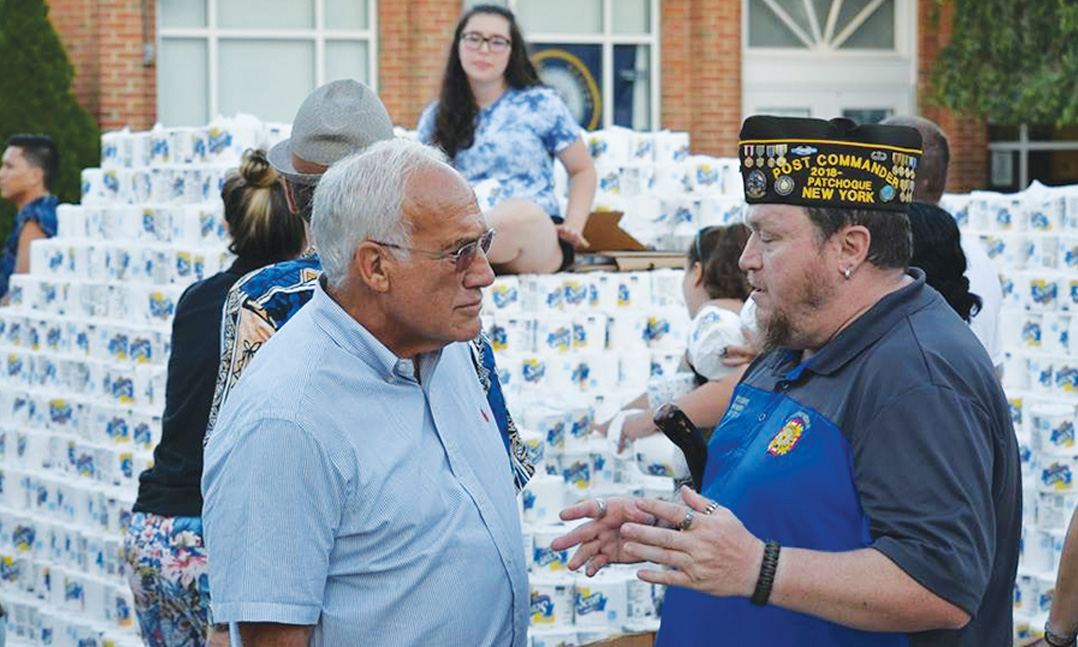News
(American Legion-Legiontown)
I joined the military at age 29, I was married with a son who was about to turn 10 the day, I left for BMT, back in June 1992. No one in my family including my then husband thought I would finish, only a few close friends, and a couple of relatives. My MOS was Services, I wanted to learn everything about running a restaurant because my grandmother had a little jazz club that served food and all of the big names used to stop by there when I was growing up. When I got to Lackland, I discovered that I was the oldest person there. I was even older than my T.I., who was a man; and we were his first female flight. I was latrine queen, and that was an experience for me, and I had worked in hotels, and the international airport as a janitor, but was fired twice for telling women that they were nasty. lol, By, week,4, I had sprung my ankle, but I wasn't going to tell anyone, because; I had to prove that I could do this. But the last week, my ankle had started to get worst, by the day before graduation, my ankle had swollen so much that; I was sent to sick call, and they had to actually cut the back of my tennis shoe up to slide my foot out. I wasn't allowed to march for graduation, for I was wrapped up and on crutches, I was yelled at for not using them properly earlier that morning of graduation by another T.I.; who informed me that I and those crutches were both properties of the United States Air Force for the rest of my entire life; if I should die, I am still property of Uncle Sam. But, my T.I. took me to a place where I could see everything and be in air condition because it was extremely hot that morning. Then, as my squadron the 3701st was marching back to our dorms, I was waiting and got into position and hobbled back in formation with them. I would cherish those days. I have worked various outside careers, and even within the military, I was able to work with all of the branches and at the Pentagon. I had broken my neck, and my first day back to work was on Sept.11, 2001. If I had it to do over again, I would have joined right after high school. I later joined the American Legion in the worst part of my life, they saved me in so many ways. I was facing losing my home, I had lost a man whom I loved, that also worked for the government and died on the job. My son was behaving badly, and I was told to go and speak with someone down there at the Legion. I did, and he helped me. A week later after I got over my petty party, I came down there, to thank everyone for their help. I mean, They helped me find a place to live, moved me clear across town; and took my son off of my hands for a couple of hours. Giving me time to think. I ended up becoming a Service Officer, then membership chairperson, then 1st vice, next becoming the first black female Commander in the state of Oklahoma for an American Legion Post, I then became 2nd Vice, was selected to go to Legion College in 2010. I got to meet the officials from the Republic of China Veteran's Affairs Administration. In 2014, I was selected as one of the Top 25 Finalist for Ms. Veteran America in Washington D.C., and once again, my Legion family helped me with purchasing the evening gowns and the other things that I needed. Although I didn't get any farther in the competition; My Legion family was there to cheer me on. I entered not thinking I would get very far in it, but; it was a worthy cause to bring awareness to homeless women veterans. I didn't realize, there was that many women veterans that were homeless and many of them had children and I remembered how I got involved in the Legion, was because I was once facing losing my home.I am always hugging a veteran and thanking him or her for their service where ever I go. A niece of mine had asked me why I always wear my Legion hat, almost everywhere I go. I told her because I never know who I might get to meet, there is always a veteran somewhere around, where you may be, who has never heard of the American Legion and what we do. And I want them to know there is always a place where they can go and feel at home among friends, who will turn into a family away from your family.So, I am proud to be in a family of those brave men and women, who are nieces and nephews of Uncle Sam, a member of the American Legion, may it last another 100 years, if the good Lord doesn't come first.Lisa A. "Legz" Milner, Past Cmdr. Tulsa Post 1, Oklahoma.
Submitted by:Lisa Milner
American Legion Education and Credentialing Policy Associate John Kamin testified April 9 before the House Committee on Veterans’ Affairs Subcommittee on Economic Opportunity. Kamin’s testimony focused discussion drafts for the Justice for Servicemembers Act, the Transition Improvement Act and the GI Bill.
The discussion drafts for the Justice for Servicemembers Act aims to amend Title 38 to clarify the scope of procedural rights of members of the uniformed services with respect to their employment and reemployment rights, and for other purposes. Presently, The American Legion believes the act fails to adequately address and support military personnel returning to civilian employment.
“The Justice for Servicemembers Act is a bill that strengthens the Uniformed Service Employment and Reemployment Rights Act (USERRA) by deeming forced-arbitration motions unenforceable for the purpose of wrongful termination complaints,” Kamin testified.
The case of Marine Corps Col. Michael T. Garrett — who was terminated from his job due to a pending active duty mobilization — was highlighted by Kamin.
“In accordance with section 4323 on enforcement rights with respect to a private employer, Colonel Garrett filed a USERRA violation in District Court,” Kamin said. “His employer filed a motion to compel forced arbitration. After much dispute, the U.S. Court of Appeals for the 5th Circuit ruled that USERRA is not a clear expression of congressional intent concerning the arbitration of servicemembers’ employment disputes. Thus, the Garrett precedent was established on USERRA violations, and hence we ask for your support on the Justice for Servicemembers Act.”
The next issue addressed during testimony was the Navy SEAL Chief Petty Officer William Mulder Transition Improvement Act. The act is the most notable improvement to the Transition Assistance Program and the overall transition process for servicemembers, including an increased focus on career opportunities and entrepreneurship.
“Notable,” said Kamin, “is its authorization of a five-year pilot program that would provide matching grant funds to community providers that offer wraparound transition services to veterans and transitioning servicemembers."
The restructuring of the act requires servicemembers to select a specific career-oriented track for their post-service plans, as well as require them to undergo one-on-one counseling a year before separation to evaluate which transition pathway best suits them.
Harry W. Colmery Veterans Educational Assistance Act, also known as the “Forever GI Bill,” brings significant changes to veteran education benefits over the coming years. Named after American Legion Past National Commander Harry W. Colmery, the Forever GI Bill is one of the major successes of the 115th Congress.
“The VA faithfully attempted to meet Forever GI Bill deadlines,” said Kamin. “Congress and VSOs attempted to provide sound oversight and support to ensure this outcome. But we failed, and thousands of veterans paid the price in delayed GI Bill payments this past fall semester.”
However, Kamin continued, “we are encouraged by improved outreach and communication on GI Bill implementation.
“It is incumbent upon all of us to take ownership in this success and support Dr. Lawrence in this endeavor, because we have lost the right to disbelief in the event of another GI Bill backlog. Oversight and support must be in real-time and practical, no matter the challenge. That means being transparent about complications and forthright on changes, open to school inputs and adaptive to recommendations. That starts with trust.”
WASHINGTON — Secretary of Veterans Affairs (VA) Robert Wilkie today announced an increase to the department’s goals for contracting with Service-Disabled Veteran-Owned Small Businesses (SDVOSB) and Veteran-Owned Small Businesses (VOSB).
For fiscal year (FY) 2019, VA seeks to award at least 15% of its total contract dollars to SDVOSBs and at least 17% to VOSBs, representing a 5% increase in both goals, a significant change not noted since 2010.
This increase reflects the department’s heightened emphasis on contracting with such firms after the U.S. Supreme Court’s decision in Kingdomware Technologies v. United States (2016), Wilkie said.
“Three years ago, the U.S. Supreme Court underscored our mandate to do business with service-disabled and other Veteran entrepreneurs,” Wilkie said. “We have increased the dollars awarded each year, but now it’s time to update the goals to reflect this new commitment. We need to lock in the gains we have made and continue to build for the future.”
In FY 2017, the last year for which official data is available, VA awarded $5.1 billion in contracts to SDVOSBs and $5.4 billion to VOSBs. These figures represent 19.5% and 20.6%, respectively, of VA’s total procurement of $26.1 billion.
The law directs VA to consider SDVOSBs first and VOSBs second, before considering other small business program preferences. Other federal agencies are covered by an SDVOSB program administered by the Small Business Administration, with a goal of only 3% for SDVOSBs. At these agencies, the government-wide SDVOSB program has equal priority with other small business socioeconomic programs.
In FY 2017, VA awarded more than one-fourth of the dollars given to SDVOSBs by the federal government, more than all other federal civilian agencies combined. Previously, the SDVOSB and VOSB goals were 10% and 12% established by former VA Secretary Eric Shinseki in FY 2010.
FY 2018 data on federal contracting is still under review by the Small Business Administration and is considered unofficial until final figures are officially released.
A VFW Service Officer in Idaho relies on compassion and tenacity to win for his clients
For Bob Smith, a monetary victory he earns for a veteran filing a VA claim is not as important as what the approved claim does for the claimant and his or her family.
For example, one of his most meaningful victories was for a surviving spouse. Smith, a VFW-accredited service officer in Jerome, Idaho, said the spouse was seeking assistance with medications.
“Her husband had passed away about 15 years earlier, and I had asked her if her husband was ever a POW, to which she had responded, ‘Yes,’” Smith said.
Bob Smith has been an accredited VFW veterans service officer in Idaho for two years. Previously, he worked as a county service officer for five years and at the Post level for eight years. Photo by Drew Nash/Magicvalley.com.
Her husband served during World War II and the Korean War. While in Korea, her husband was shot in the leg and captured one week later, according to Smith. In looking at the husband’s death certificate, Smith saw that he died of complications from a heart condition. That being the case, he helped the surviving spouse file a dependency and indemnity compensation (DIC) claim, which can be submitted when a veteran dies from a service-connected illness or complication. She heard back from VA in 26 days.
“It was the fastest claim I have ever received back,” Smith said.
But it wasn’t until six weeks after receiving her award letter that the spouse reconnected with Smith. She told him she was “scared” of opening the envelope. They opened it together, according to Smith, for the surviving spouse to discover that she had received $14,426 — one year’s worth of DIC retro pay compensation.
“They paid her one year, even though he’d been dead for 15 years,” Smith said.
Going forward, she would receive roughly $1,586 per month, and, Smith said, she would be able to drop her supplemental insurance and enroll in Champ VA.
“That isn’t the highest monetary award, but it’s the one that made the most impact on a dependent,” said Smith, who remains friends with the spouse to this day.
Smith, who served as a Marine scout sniper during the 1991 Persian Gulf War with the Surveillance Target Acquisition Plt., 3rd Bn., 7th Marines, Task Force Grizzly, has been a state service officer for two years. Previously, he spent five years as the Jerome County, Idaho, service officer and eight years at the Post level with VFW Post 2136 in Twin Falls, Idaho.
Smith said he became a service officer after losing his employment “due to service-connected injuries” and wanted to continue expanding services to veterans in his community. Each time he made the jump to a new service officer position, he said it was simply to reach more veterans.
The most rewarding part of his job is that everything service officers do has a “positive impact” on a claimant, whether that be a veteran, dependent or surviving spouse. However, the most challenging, according to Smith, is battling veteran homelessness — most notably the lack of “adequate housing” and transportation.
The most common cases Smith sees — roughly 80 percent — focus on pensions. That is due to the demographics in Jerome, Idaho, which he said is a “retirement community.” Between himself and one administrative assistant, his office handles roughly 1,200 cases annually.
To anyone just beginning as a service officer, Smith said “going the extra mile” is important.
“There’s always one more thing that we can do to assist veterans and their dependents,” Smith said.
Editor’s note: This is the second in a series of feature articles on VFW’s accredited veterans service officers. In 2019, VFW is commemorating 100 years of existence of its National Veterans Service and National Legislative Service offices in Washington, D.C.
This article is featured in the March 2019 issue of VFW magazine, and was written by Kari Williams, associate editor of VFW magazine.
It’s never wise to assume that any data is breach-proof and keeping up with trends is essential
April 03, 2019
Cybersecurity is based on constant escalation of the technological stakes. Every new advancement in defensive technology seems to be met and surpassed by criminals and their latest developments. Then the cycle goes around again.
This proverbial arms race has kept the question of personal data security relevant for years, even as the systems used to store, transfer and process data have reached new levels of sophistication. It’s never wise to assume that any data is breach-proof and keeping up with trends is essential. Enterprise IT departments and individual internet users alike should strive to understand every possible repercussion for using latest tech. It pays to know what kinds of systems are going to be in place around valuable personal information and the parallel advances being made by hackers. The state of the industry is always in flux, because new cyberattack methods demand immediate and effective countermeasures.
Pondering AI’s PotentialArtificial intelligence is an area of technology that has gone through some changes in perception over the past few years. While AI has existed as a science fiction concept for decades, recent years have seen it applied in advanced machine learning operations and data analytics. These innovations can digest huge amounts of information in short periods of time, allowing decision-makers to make informed and optimized choices based on data-supported variables.
The path forward for AI-based security tools is based on with these algorithms proving their worth against “novel” attempts to break into systems, according to Wired. Standard cyber defenses create shields against known attack types, then close those loopholes. Employing AI to help predict new threats by analyzing past data hacks, and to detect unobserved intrusion attempts could help protect a great deal of data.
The development of these artificial solutions has given rise to a new view of defenses. Instead of focusing on developing strong walls to protect information, AI-based approaches are more like creating a new version of the body’s immune system in addition to those walls. The latest algorithms could get an inside view of networks and figure out instantly when something goes wrong.
Using AI TodayWatching companies develop their defensive technologies shows how far cybersecurity has come in the past few years. But why wait for the next-generation of innovations, when you can start using an AI enabled solutions to start protecting your personal information today. While some companies are slow to use AI, Identity Guard is working to embrace augmented intelligence programs like IBM Watson to help consumers become proactive about protecting their identities. Information can leak from personal accounts or corporate databases, and the amount and sophistication of cyberattacks remain elevated.
The push-and-pull battle between internet users and the criminals who want to steal their data is ongoing, and the financial stakes are high. Get protected today with Identity Guard® to help keep an eye on issues that may inflict harm.
By Mark Seavey - The town of Florence, Ariz., paid tribute March 30 to one of its most famous former citizens: Ernest W. McFarland, the U.S. senator who sponsored the Servicemen’s Readjustment Act of 1944, 75 years earlier. Drafted initially on stationery at the Mayflower Hotel in Washington, D.C., by American Legion Past National Commander Harry Colmery, the GI Bill was signed into law by Franklin Roosevelt on June 22, 1944.
McFarland, along with 1943-1944 American Legion National Commander Warren Atherton, shepherded the legislation through Congress and are jointly considered the “fathers of the GI Bill.”
The day began with a parade through the center of Florence, a town of around 33,000 people roughly an hour southeast of Phoenix in Penal County. Bordered to the east by the scenic Superstition Mountains, Florence is one of the oldest towns in the area and its National Historic District has more than 25 buildings listed on the National Register of Historic Places. The parade featured a horse-mounted color guard, floats from various local civic groups and politicians, and old jeeps. Children carrying small American flags lined the sides of the main street and scrambled to recover candy thrown by those in the parade – like Department of Arizona American Legion Commander Steve Aguirre.
“It is extremely important that the Legion Family must continue to think outside the box when it comes to educating the veteran community and the general public about our mission and the accomplishments of the organization,” said Aguirre, noting the importance of Legion visibility in community events like this.
“We, as veterans and members of the largest wartime, all-volunteer veterans organization in the world, know our story of community service, programs for our youth, veterans advocacy, promoting Americanism and advocating for a strong national defense,” he said. “Yet there are thousands of veterans families in our communities that have never heard us explain who and what The American Legion does for veterans and the community at large.”
Florence Post 9 Commander Jose Maldonado agreed.
“It feels great to know that The American Legion was instrumental in not only myself and others receiving this benefit, but I also went as far as to find out that in 2017 President Trump signed the Forever GI Bill extending the allowable time period for veterans to pursue educational opportunities.”
McFarland family members served as grand marshals for the parade and spoke at a gathering in the town’s park afterward.
“My grandfather, Ernest McFarland, who preferred to be called ‘Mac’ would be deeply honored that his hometown people here in Florence are recognizing him and his works here today,” said John D. Lewis, McFarland’s grandson. “The hardest job that my brothers and sisters and I have here is as we go out to preserve my grandfather’s legacy, is that my grandfather did so much.”
Indeed, it would be difficult to overstate the impact McFarland had not just on Florence but all of Arizona.
“If Arizona had a Mount Rushmore, the men on it would be Carl Hayden (a longtime Arizona U.S. senator), Ernest McFarland, Barry Goldwater and John McCain,” Arizona State Historian Marshall Trimble once noted.
Born in an Oklahoma log cabin in 1894, McFarland enlisted in the U.S. Navy following the outbreak of war in 1917. Sent to the Great Lakes Naval Station to train, McFarland took ill with a lung disease that left him hospitalized for 10 months and nearly killed him. Following his honorable discharge two years later, McFarland moved to Arizona which doctors felt would be a better climate for him to recuperate in. McFarland studied law at Stanford before returning to Penal County to pursue his legal career, where he served as county attorney and then was elected as a Superior Court judge.
In 1941, McFarland ran for U.S. Senate, handily winning both the Democratic Primary and then the general election. He served in the Senate until 1953, as the Majority Leader for the final two years. Following a loss in his 1952 re-election bid, McFarland returned to Arizona where he served as governor from 1955-1959, and then as associate justice and later Chief Justice of the Arizona Supreme Court from 1965-1971. McFarland was the first, and thus far only, Arizonan to serve in the highest offices of all three branches of Arizona government.
But it was for his work on the GI Bill that McFarland made the biggest impact on veterans.
“He sponsored over 40 veterans’ bills,” noted a 2016 Arizona Times article about McFarland, “but his greatest contribution rested in drafting the portions of the Serviceman’s Readjustment Act of 1944 – the ‘GI Bill’ – that gave veterans access to education through tuition assistance, zero-down home loans, and low-interest business loans. It improved the lives of nearly 50 million ex-servicemen and women, along with millions of their dependents. According to one historian, the GI Bill generated 450,000 trained engineers, 91,000 scientists, 67,000 doctors, 22,000 dentists, 238,000 teachers, and more than 1 million other college-educated professionals.”
“My grandfather, to us, was just our grandfather,” Lewis said. “We never really knew what a political giant he was until we got older. And for me, I didn’t really realize the breadth of all he’d done until 10 years ago when I went through all his papers.”
Representatives from the office of Arizona Gov. Dan Ducey and Florence’s member of Congress, Paul Gosar, were on hand for the ceremony in the town square, as well as members of the State Legislature and Florence Mayor Tara Walter. Each brought a proclamation for McFarland’s family to mark his signature legislative accomplishment 75 years earlier.
Aguirre was humbled and honored that he could speak at the event as well, telling the story of the organization he leads in Arizona during its centennial year. “It was simply amazing how the event was educational and yet told the story of how The American Legion was involved in (the GI Bill’s) creation,” he observed.
(Stars & Stripes) SOTO CANO AIR BASE, Honduras — For the frequently rotating cadre of U.S. soldiers and airmen with Joint Task Force-Bravo in Honduras, success can be a tricky thing to measure.
Their assignments last six months to a year, with some as short as 90 days – little chance to see the fruit of one’s labor.
But Lt. Col. Patrick Blankenship, commander of the task force’s Army Forces, had an aha-moment late last year when the unit’s medical element was on a mission in northern Honduras, which 20 years earlier had been devasted by Hurricane Mitch.
Mitch was the kind of cataclysmic event that leaves survivors forever dividing their lives into the before and after. It killed more than 11,000 people when it hit Central America in October 1998. Honduras took the brunt of the storm, with more than 7,000 killed, mostly due to flooding.
During last year’s mission to the region hit hardest, a local television reporter told Blankenship of his experience in the 1998 storm when he was just 14 years old.
The boy had stood with his mother on a building rooftop in the town of Saba, surrounded by water with only the tops of banana trees poking above the surface.
“He remembered seeing endless streams of helicopters from JTF-Bravo picking people up off their rooftops,” Blankenship said. “He wanted to say thanks for that. That was one of those moments like, ‘Yes! This is great. You don’t get that all of the time, but people here have a deep-seated memory of the good things they’ve experienced from the United States and JTF-Bravo specifically.”
As the U.S. Defense Department’s longest-standing joint task force, Bravo has been the face of America’s military presence in Central America since it was established in 1983.
For the past two decades, the task force has focused on enhancing security and stability in Central America, particularly by providing disaster assistance to a region whose major exports are coffee, cacao and bananas.
It conducts that mission with a relatively small number of people. Roughly 1,200 Americans — almost 600 of whom are servicemembers — work out of Soto Cano Air Base, which also houses the Honduran Air Force Academy.
Joint Task Force-Bravo’s 612th Air Base Squadron oversees America’s sole military airfield in Central America, the only one in the region capable of handling the Air Force’s largest plane, the C-5 Galaxy.
The 228th Aviation Regiment operates a fleet of helicopters used for medical evacuations, counter-narcotics missions, search-and-rescue and disaster relief throughout Central America. The regiment shuttles Army Special Forces teams throughout the region on numerous joint training and counter-narcotics missions.
The medical element, staffed by rotating deployments of Army Reservists, is the only expeditionary medical unit capable of performing surgery in Central and South America.
Harsh spotlight
America’s role in Central America has been thrust into the spotlight in recent months as President Donald Trump amped up criticism of Central Americans seeking amnesty at the U.S. southern border.
A medical helicopter with the 228th Aviation Regiment lands as the sun sets behind the mountains overlooking Soto Cano Air Base, Honduras, March 7, 2019.WYATT OLSON/STARS AND STRIPES
In the weeks before the November midterm elections, Trump issued alarmist tweets and statements about “caravans” of migrants moving north through Central America in a quest for amnesty immigration in the United States. He threatened at that time to cut off aid to the region, and in late March, the U.S. State Department said it planned to end all aid to Honduras, El Salvador and Guatemala.
Anti-immigration rhetoric labeling Central American immigrants — trying to escape poverty, violence and corruption — as “invaders” and “animals” has not bolstered neighborly ties.
“It angers people in Central America, as it would in any country,” said Mark Schneider, a senior adviser with the Americas Program and the Human Rights Initiative at the Center for Strategic and International Studies, a think tank in Washington, D.C.
“Obviously that hurts the relationship,” he said. “But I don’t see that directly transformed into the public being angry at other U.S. institutions.”
Neither does Col. Kevin Russell, commander of Joint Task Force-Bravo.
“In this region of the world, relationships matter, and they matter deeply,” Russell recently told Stars and Stripes at his office on Soto Cano Air Base. “When you have an enduring relationship over 36 years — almost 37 years — that means a lot ... to our partners here in Honduras, our host nation, but then also in the region.
“So, when there’s a bit of rhetoric out there that says, ‘Hey, the U.S. is changing their stance and we don’t care as much about Central and South America as we did in the past,’ this place stands as a strong, very strong message — in my opinion — that no, nothing could be further from the truth.
“That hasn’t changed, and by all accounts I don’t think it will change.”
Evolving U.S. role
U.S. military involvement in Central America, however, has morphed over the past four decades.
In the 1980s, efforts were focused on rolling back Soviet Union-backed communist influence — a goal that at times led to America supporting militaries of harsh regimes.
Under President Ronald Reagan’s administration, right-wing Nicaraguan Contra rebels were trained in Honduras to overthrow the socialist Sandinista government in nearby Nicaragua. By 1987, more than 1,000 personnel were assigned to Joint Task Force-Bravo.
With the collapse of the Soviet Union in the early 1990s, Bravo’s emphasis shifted to countering the flow of illegal narcotics and providing humanitarian assistance, and it has responded to numerous regional disasters such as earthquakes, hurricanes, volcanic eruptions and flooding.
Under Trump, the State Department’s updated strategy for engagement in Central America is “addressing the security, governance and economic drivers of illegal immigration and illicit trafficking.”
Blankenship said that at a tactical level, the task force’s medical training and humanitarian assistance missions dovetail with that updated strategy.
“I think what we have done in the past and what we currently do nests well within that, and we haven’t been given any direction to do something different as a result,” he said.
WASHINGTON — Today, the U.S. Department of Veterans Affairs (VA) announced the availability of up to approximately $15 million in grants for community organizations that provide adaptive sports, including therapeutic recreational opportunities for disabled Veterans and disabled members of the armed forces.
VA awards grants to qualifying organizations to plan, develop, manage and implement programs serving Veterans.
“Grants help our nation’s Veterans by increasing and expanding the quantity and quality of adaptive sports opportunities at community organizations across the country,” said VA Secretary Robert Wilkie. “The independence, challenge and enjoyment of sports and recreation play a critical role in their successful rehabilitation and can improve their health and well-being.”
VA will make award decisions this fall based on a competitive selection. In fiscal year 2019, VA awarded approximately $9 million in Adaptive Sports Program grants to 103 organizations, estimated to serve more than 10,000 Veterans throughout all 50 states, the District of Columbia and Puerto Rico.
Details of the Notice of Funding Availability, including how to apply, can be viewed under the “Grant Program” tab online at VA Adaptive Sports Grant Program. All submissions will be accepted online at www.grants.gov. The deadline for applications to be submitted is May 14.
Follow VA Adaptive Sports on Instagram, Twitter or Facebook at @Sports4Vets.
When members of Post 2913 in Patchogue, N.Y., sought to build the world’s largest pyramid of toilet paper, they took to social media to spread the word.
The end result was 15,000 rolls of toilet paper donated and distributed.
According to Post Commander Dave Rogers, 3,000 rolls went to a battered women’s shelter, and the remaining 12,000 were donated to homeless veterans shelters.
VFW Post 2913 Commander Dave Rogers (right) speaks with Patchogue (N.Y.) Mayor Paul Pontieri as the community builds a pyramid of toilet paper in July. Photo courtesy of Post 2913.
Rogers said it was brought to his attention that there is no funding for basic toiletry items for those living in homeless shelters.
Together with organizations comprising the United Veterans of Patchogue, Post members took action. Rogers sent more than 800 emails, made 200 phone calls and visited more than 100 businesses.
Members also launched individual efforts, like standing in front of supermarkets and asking people to donate to the project.
“This is the heart of what the VFW is about,” said Rogers, who served in the Army during the 1991 Persian Gulf War and later in Bosnia in 1997. “Not waiting for others to fix the problems, but getting our hands in there and making things happen.”
While his Post did not beat the world record of 25,585 rolls needed to build the world’s biggest toilet-paper pyramid, Rogers said everyone involved was pleased with the end result. Several VFW Posts as well as American Legion posts, church groups, Scouts and businesses contributed. Rogers added that without the use of social media, it would have been much more difficult to spread the word. Two years ago, Rogers started building his Post’s social media outlets — specifically Facebook, Twitter and Instagram — to distribute information, notices and updates about the Post.
“We had a Facebook page, but no one ever did anything with it,” he said. “I decided I would take it over, so I just ran with it. It’s been going great. It’s done a lot for our Post.”
For the members who don’t use social media, they still receive letters and flyers in their mailboxes.
“I think the trick is to find that balance,” Rogers said. “The last thing you want to do is alienate someone.”
Rogers said that he uses the hashtag #vfwpost2913 to help his social media posts reach the full audience. He also is diligent in “tagging” sponsors and businesses as a way to thank them and draw attention to their generosity. Most importantly, Rogers said that using social media lets the community know that VFW Post 2913 is out and about doing good things.
“I had a guy walk up to me at an event and tell me he had seen us online,” Rogers said. “He wanted to join our Post because of everything he had been seeing.
“Social media has allowed people to know where our members are going to be and what we have going on.”
Rogers said that because of social media, the Post had its best year in 2018 with Buddy Poppy distribution. Another example of putting social media to work is when they collected 500 pairs of shoes for homeless veterans.
“Social media does work when used appropriately,” Rogers said. “It encourages people to get involved. And none of what we do would be possible without community support, and a lot of the community is focused on social media.”
He added that he still prints flyers to promote events, but that he doesn’t have to print as many since one social media post can reach 500 people.
“The other really positive thing about all of this is that it gives us the opportunity to share and receive new ideas,” Rogers said. “And sometimes we could all use new ideas to keep growing."
This article is featured in the March 2019 issue of VFW magazine, and was written by Janie Dyhouse, senior editor for VFW magazine.
Intent to promote whole health and wellness goals of Veterans and families
WASHINGTON — As part of the U.S Department of Veterans Affairs (VA) efforts to advance and improve the lives of Veterans living with multiple sclerosis (MS), the department announced its recent partnership with the National Multiple Sclerosis Society.
The partnership, formalized on March 6, will continue to build upon VA’s national network of MS clinical services, education and research.
VA Secretary Robert Wilkie said VA is committed to working closely with Veterans and their caregivers, community health care professionals, MS advocates and Veterans service organizations to identify new and innovative ways to support this initiative.
“MS can be an overwhelming challenge for those who are fighting the disease and their loved ones who care for them,” Wilkie said. “VA recognizes and values the strength of collaborations with our external partners, which can help increase access to care and lead to a more fulfilled quality of life.”
VA and the National MS Society seek to enhance health services, education, self-efficacy and promote whole health goals of Veterans and their families, by sharing certain resources and collaborating on policy, educational and research initiatives.
“Veterans living with multiple sclerosis need our support,” said Cyndi Zagieboylo, president and CEO of the National MS Society. “This agreement is a very clear commitment from the federal government and the society that we are here for them — and will be here for them.”
According to the National MS Society, nearly 1 million people are living with MS in the United States. Approximately 20,000 Veterans with MS are cared for annually in the Veterans Health Administration. With the 2003 establishment of VA’s MS Centers of Excellence, Veterans and their families have access to a national network of regional and support programs to improve their diagnosis and treatment.
For more information about VA’s National MS Centers of Excellence, visit VA Multiple Sclerosis.
